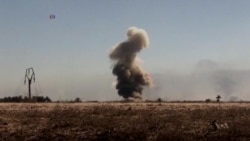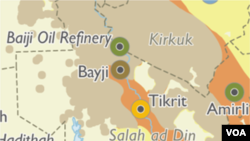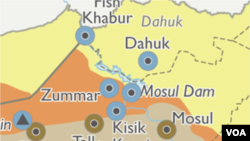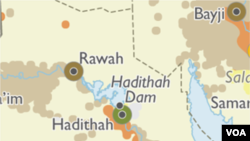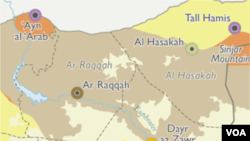U.S. defense officials are touting slow, but steady gains in the effort to degrade and destroy the group known as the Islamic State.
The Pentagon says IS has lost 13,000 to 17,000 square kilometers of territory since coalition airstrikes began in August 2014, reducing its holdings in Iraq by 25 to 30 percent.
“ISIL has lost large areas where it was once dominant,” said Pentagon spokesman Army Col. Steve Warren, using another acronym for the group. “Iraqi security forces along with coalition air power have unquestionably inflicted some damage on ISIL and have begun to push ISIL back.”
Still, U.S. military officials remain cautious, noting some key areas where Iraqi forces have engaged the Islamic State group remain contested.
“This is a long fight,” Warren said. “It's a little early to come out and say the tide of battle is turning."
Currently, the United States has 3,040 troops in Iraq - 2,240 to support the Iraqi Security Forces and 800 designated for security and force protection.
Baghdad
In July of last year, there was concern the rapid advance of the Islamic State group threatened the Iraqi capital.
“We continue to see ISIL putting pressure on Baghdad from the north and the west,” then-Pentagon spokesman Rear Admiral John Kirby said at the time.
Today, Baghdad remains under the control of the Iraqi government, while Iraqi security forces have pushed the militants back in areas around Jurf as Sakhr, southwest of the capital, and to the northwest, near Fallujah, although Fallujah remains under IS control.
Tikrit
Iraqi Prime Minister Haider al-Abadi walked through the streets of Tikrit April 1, calling the city’s recapture from Islamic State fighters a “milestone.” Pentagon officials say while Iraqi forces have made major gains, there is still some resistance and list the city as contested.
Even getting to that point was not easy. Despite help from Iranian-backed Shia militias, the Iraqi campaign stalled, making progress again only after the militias agreed to hold back, clearing the way for coalition airstrikes.
Tikrit is now part of a corridor in Saladin province that has mostly been liberated from the Islamic State group, although the city of Bayji remains contested. Slightly to the north of Bayji, the Baiji oil refinery is currently held by Iraqi forces but has gone back and forth several times. U.S. military officials have reported increased fighting in the area in recent days.
Mosul
A steady bombardment by coalition warplanes and a concerted push by Iraqi Kurdish security forces has helped push the Islamic State militants back from large swaths of its northern holdings in Iraq, including the critical Mosul Dam.
The city of Mosul, though, remains under Islamic State control, held by an estimated 2,000 Islamic State fighters. In February, an official with the U.S. Central Command said an Iraqi and Kurdish military force of about 20,000 to 25,000 troops was being prepared to retake the city in a campaign likely to begin in April or May.
U.S. officials have since backtracked from those comments, although a campaign to retake Mosul is seen as a critical step in the campaign against IS.
Anbar province
Islamic State fighters continue to hold territory stretching across Anbar province, mostly along the length of the Euphrates River. Some Iraqi officials have suggested these areas, and not the key city of Mosul, could be the next target for Iraqi forces in their campaign against the Islamic State militants.
As of early April, the Pentagon said discussions about the next step of the campaign were “ongoing.”
Key contested areas in Anbar province include the city of Ramadi. Meanwhile, Iraqi government forces are holding Hadithah, Hadithah Dam and al-Asad Airbase. The airbase is currently home to U.S. troops and other coalition troops assisting the Iraqis and has come under attack from Islamic State fighters.
Syria
U.S. and coalition airstrikes in Syria have mostly focused on the town of Kobani (identified on the map as Ayn al-Arab), which was freed from Islamic State control in late January following a push by Syrian Kurdish forces, who also hold Tel Hamis.
Still, U.S. officials say despite losses in those two areas, Islamic State “has maintained its overall area of influence.”
“ISIL has been able to gain some ground in the vicinity of Damascus and Homs as well as a foothold in the Yarmouk Refugee camp south of Damascus,” said Pentagon spokesman Col. Steve Warren.




